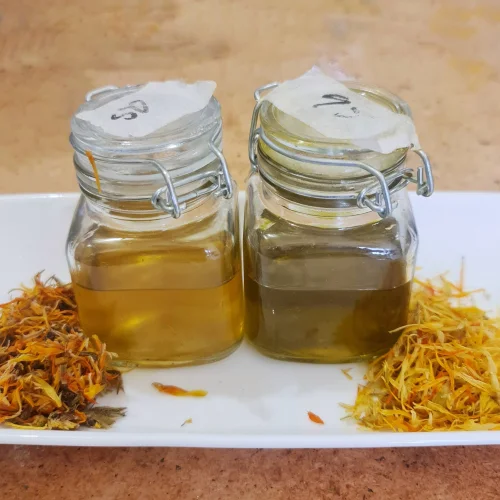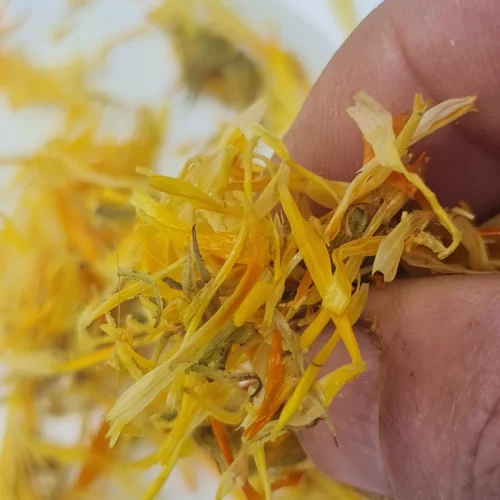Tinctures - why alcohol concentration is important to herbalists

Folk tinctures are easy to make from the plants in your @hivegarden but you can fine tune your tincturing technique by choosing the right concentration of alcohol. Different constituents of the herb are best extracted at certain concentration ranges of alcohol as you will see in the Calendula example that follows.
Alcohol is a mix of ethanol and water, the percentage you read on the label is the percentage of alcohol in the liquid, the rest is water. That means 40% alcohol is also 60% water. The percentage is called ‘ABV’ or ‘alcohol by volume’. Double the alcohol percentage and you get the ‘proof’. For example, 80 proof is 40% ABV.
When you are making tinctures in your kitchen, you will, probably, be using Vodka which is around the 40% mark. As you know from the above paragraph, that’s 40% alcohol, 60% water. Vodka is a fine solvent. It is easily available and you can get it in the 40-60% range.
Some of a herb’s constituents ae soluble in water, some in alcohol. That makes knowing what is in your herb important when choosing the concentration of alcohol.
Calendula (Calendula officinalis) is a great example of how different concentrations of alcohol can perform differently on the same herb. The colour of the Calendula petals won't affect the final tincture, they do however affect the colour of the marc. That was taken into consideration for this example and a roughly equal proportion of yellow and orange were used for each test.
In our example for this post, I macerated (soaked in alcohol) two lots of Calendula in different strengths of alcohol – 50% and 95%. The Calendula flowers all came from the same batch, harvested earlier in the day from our garden and a neighbour's place. Both samples were macerated for a month, in the same location (on top of the fridge 😉) They were shaken with the same frequency and roughly the same amount. In other words, they were treated the same.
After a month, both jars were filtered and you can see the results. If you compare the pictures of the marc (the leftovers after filtering), you can see that the 50% concentration left the petals with a lot more colour than the 95% did. It’s hard to tell from pics but I can tell you that the 50% were still soft and squishy and clumped together when squeezed. Those that were macerated in the 95% have lost much more colour and were almost dry to the touch nor would they clump together when squeezed into a ball.


If you look at the pics of the filtered tinctures (below), you can see that the 95% is a lot darker than the 50% and though I couldn’t get a decent pic of it, it is a little oily.

What could be the reason for this? The constituents that give Calendula flowers their amazing colour and some of their healing ability (they are potent anti-oxidants that benefit blood vessels, especially the smaller ones capillaries) are water soluble or soluble in low concentrations of alcohol.
But if you’ve ever picked a number of Calendula flowers, you will know that your fingers end up sticky and a greenish brown. That’s caused by a resinous material that contains most of Calendula’s healing compounds and resins are only soluble in higher concentrations of alcohol. A little is drawn out from the flower heads by lower concentrations of alcohol but not much.
Do we need to go to 95% ? No, for kitchen herbalists, 40-50% alcohol gets us most of the way to a great healing tincture that is good enough for day to day use.
If you’d like to discover more about the ins and outs of using alcohol as a solvent, check out our ""A little about alcohol" page and our "Tincturing" pages on our website Ligaya Garden Online. I'll be covering more on tincturing and other forms of remedy making here on Hive as time goes by.






Thank you @ewkaw and @qurator
I learned a lot again (as always). And I think I am going to need this.
Thank you! It's good to know the info is appreciated
You're welcome (^_^)
Very interesting topic I know nothing about! But what does Calendula tincture do? You drink it, yeah? :]
'What does it do' is the wrong question to ask an herbalist. We think more along the lines of 'how can we be helped by Calendula' otherwise the plant becomes just another commodity, not an active part of healing.
Calendula can help with many cases of inflammation, it helps with some digestive problems too. Mostly, it's biggest benefit is that it can help build new capillary beds, making it a premiere herb for helping our bodies heal wounds and prevent infections. It can also help if our lymphatics are congested, helping shift wastes, especially in cases of injuries and infection when waste materials build up.
Speaking of waste, Calendula also aids our liver in its job of eliminating waste.
Wow! What a friend to have in our gardens.
I ask, not in service of reductionist preconceptions, but out of curiosity!
Thanks for your reply, dear Herbalist.
Perhaps I need to look out for some Calendula to add to my own garden.
No question 8s a bad one I just like to steer folks away from the idea that plants are here for humans
@ligayagardener thank you for this very interesting information. My mom makes some herbal tinctures with brandy and uses them topically.
No worries! Happy to share. Brandy is an excellent solvent. Tasty and warming too!
This was very interesting! I’d never come across this info before. Another really informative post!
Thanks, there's more to come. Please feel free to share around anything I post
Hello my friend! 😊
This gave me a better understanding of something that had confused me in the past. Thanks for sharing! 😊
God bless you and yours. Have an awesome day my friend! 😊
No worries! I'm going to be posting a few more posts on tincturing soon, so keep an eye out. Please feel free to share around anything I post. Enjoy your herbal journey
I will definitely keep an eye out for your future posts. Thanks, I will share them to Facebook, so my daughter-in-law and friends can learn too, if they care to. 😊
No worries. We have a Facebook account too https://www.facebook.com/ligayagarden
but I mostly put stuff on our website.
Thanks! I'll share the Facebook link too, so they can find you there as well. 😊